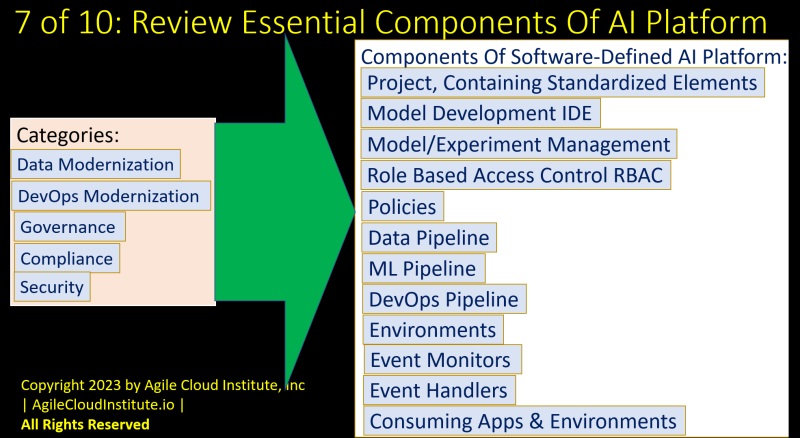Agile AI Platform Architecture with the Agile Cloud Manager
Part 7 of 10: Review Essential Components Of AI Platform
The entire transcript of this video is given below the video so that you can read and consume it at your own pace. We recommend that you both read and watch to make it easier to more completely grasp the material.

So let’s review the components that are required in an A.I. platform.
There are several general categories, which include:
- Data modernization. This includes a data lake house with a centralized data catalog. And an enterprise-view of data including shared data pipelines and reusability of data.
- DevOps modernization includes using infrastructure as code and configuration as code so that all environments become software-defined and ephemeral.
- Governance includes an enterprise-level view of the architecture of every system. Governance also includes the definition of process flows that ensure that all of the data and code flowing through the organization’s work is able to adhere to governance requirements.
- Compliance has to do with living up to government regulations. A.I. has its own set of government regulatory issues that are different in each part of the world, and which need to be addressed before an organization can deploy A.I. models in a given region in the world.
- Security involves shrinking the size of the enterprise attack surface and also protecting the smaller attack surface after the size of the attack surface has been reduced.
Agile Cloud Manager makes it easier to manage all of these categories of A.I. platform components.
- Agile Cloud Manager accelerates DevOps modernization by enabling you to drastically reduce the amount of code required to define and operate on each of the systems which together define your enterprise.
- Agile Cloud Manager makes data modernization easier by enabling you to more easily manage software definitions of all elements of a data platform, including data lake houses and A.I. platforms.
- Governance becomes easier with Agile Cloud Manager because each of the smaller number of templates can more easily be put under project management.
- Compliance becomes easier with Agile Cloud Manager because you can focus your compliance efforts on a smaller amount of code.
- Security similarly becomes easier because you can focus all of your security efforts on the smaller amount of code which works out to be a smaller enterprise attack surface.
Now let’s take a look at the more granular list of items in a software-defined A.I. platform that you can create using templates that can be orchestrated by Agile Cloud Manager.
Some of these items include:
- A project, containing standardized elements.
- A model development environment.
- A system for managing models and experiments.
- Role-based access control.
- Policies.
- A data pipeline.
- A machine learning pipeline.
- A DevOps pipeline.
- Environments.
- Event monitors.
- Event handlers.
- Consuming applications and environments.
Let’s look at this entire slide for a moment now that we have populated the entire slide.
Agile Cloud Manager makes it easier for you to create and manage A.I. platforms that include all of these components.
The next two slides will describe two working examples that you can download from the AgileCloudInstitute.io web site and use to seed your A.I. platform development projects. (They are labeled as data lake house appliances, and each includes an AI project management platform.)
Proceed to Part Eight: Azure Example Appliance
Back to Series Table Of Contents: Agile AI Platform Architecture With Agile Cloud Manager